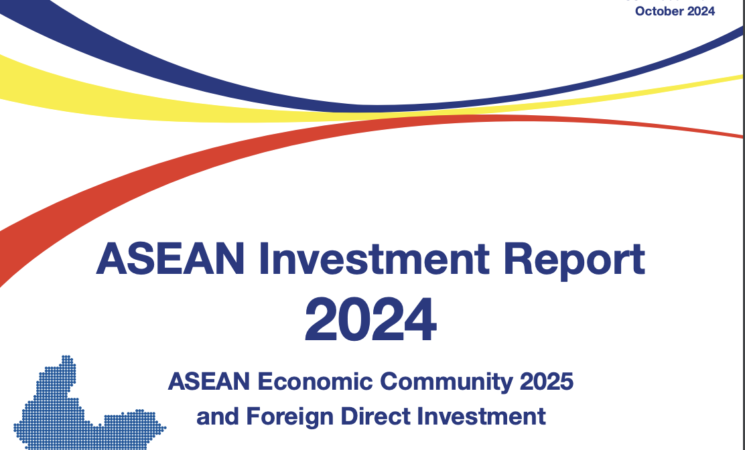19 October 2024, NIICE Commentary 9671
Dr. Chander Shekhar
Amidst the world undergoing wars in two sub-continents (Eastern Europe and the Middle East), nations are still struggling to come out of COVID-19 shocks, economic recovery and a regime change in Sri Lanka and Bangladesh due to domestic economic turmoil. These trends have caused wider ramifications on world economies as well. Among others, the Association of Southeast Asian Nations (ASEAN) during its October 2024 Summit led by Lao PDR, as a chair, released a major document, called the ASEAN Investment Report (AIR) that focuses on ASEAN Economic Community Vision 2025 and Foreign Direct Investment indicators. The AIR demonstrates an upward trajectory in investment trends in the given unstable world order, and moved on to achieve the nascent stage of building an economic community among its members by reducing tariffs and liberalized norms in the era of counter-globalization and protectionism.
Outcomes
The ASEAN, grouping of ten Southeast Asian countries, was founded on 8 August 1967 in Bangkok, Thailand, with the Bangkok declaration outlining the organization’s future roadmap. The objective of Bangkok declaration is to “promote regional cooperation in the region for peace, progress and prosperity” through shared responsibility. In that direction, the blueprint of the AEC was adopted, which gave green signal to the AEC establishment in 2015. Likewise, ASEAN Concord I and 2012 ASEAN Concord II, which is also known as Bali Concord, seeds the idea of comprehensive integration of Southeast Asian region in three areas, political and security, economic and socio-cultural cooperation to realize community-building goals in these fields. Among others, the objective of AEC, with a market size of USD 2.3 Trillion and 600 million people, to integrate regional markets through regional economic integration process.
The ASEAN Investment Report presents the investment trends in the region, which is prepared with the joint cooperation of the UNCTAD and the ASEAN Secretariat. The report was released on 9 October 2024 under the theme of “ASEAN Economic Community 2025 and Foreign Direct Investment”. According to the AIR report, in spite of global challenges, the ASEAN for the past three consecutive years has maintained the pace and position to be at the top of FDI recipients among developing countries. Research study notes that between 2006 and 2015 the FDI inflows were recorded around USD 92 billion, which later witnessed a double the figure averaged USD 170 billion since 2016.
In the year 2023 alone, the total volume of FDI inflows to the ASEAN has reached historically at USD 230 billion. It is forecasted that it could reach a further USD 300 billion in the years ahead. It was noted that the region has also gained focus on digital and green technologies and risen as “a global hub” for financial and digital services including manufacturing. India’s contribution to this transformation has been at the onset noteworthy in the implementation of ASEAN Digital Masterplan 2025, the establishment of the ASEAN-India Fund for Digital Future, and the sharing of knowledge with partners, noted during the 21st ASEAN-India Summit.
ASEAN-China’s cooperation in digital technology has also facilitated cultural exchanges and strengthened mutual understanding, celebrating the 2024 year as China-ASEAN Year of People-to-people exchanges. The report captured the sentiments of investors' interest in sectors like Renewable Energy (RE), Electric Vehicle (EV), and digital connectivity and economy. It also recognizes the role Multi-National Enterprises (MNEs) have played in the region’s “economic integration, technology upgrading, and sustainability agenda”. Moreover, this report comes at a time when the ASEAN is about to achieve its 2025 ASEAN Economic Community targets and finds loopholes for the post-2025 phase to deal with existential and emerging challenges in areas such as “trade, services, digital, skills or reskilling and technology”, in align with the Sustainable Development Goals goals.
In the age of new emerging dynamics and technology, the up-skilling workforce in the ASEAN region is the priority of these countries to prepare human resources as per industry requirements and change in a new era for a common destiny. The ASEAN’s strength lies in its beliefs of continuity, unity in diversity, regional integration, and resilience. The purpose of the ASEAN Economic Community 2025 has been realized to achieve an integrative and cohesive ASEAN economy that could be resilient even during tough times like crisis and sought to enhance ASEAN’s role and voice in global economic for broader interests.
The United Nations Conference on Trade and Development believes that the report underscored the momentum that the Southeast Asian countries have achieved with a “favorable investment climate”, and maintained consistency in regional integration and GDP growth.
Future Insights
The AEC 2025 document has played a substantive role in strengthening ASEAN’s economic indexes, especially featured as creating a conducive economic environment, strengthening regional integration, and connectivity, and improving investment patterns with the win-win cooperation approach. In the region’s growth of connectivity, industrial development, and supply chain global investment has provided stimulus to make Southeast Asia a future investment hotspot, which was once known for regional confrontations between countries.
It has the potential to converge with other economic powers like Japan, China, Australia, India, the United States, and so on. The future of the Southeast Asian economic community depends on the geopolitical atmosphere that has been unfolding in the South China Sea, a regional territorial conflict over several features between various states, setting new alignment and equations with major powers.
Dr. Chander Shekhar is an Assistant Professor at PES University, Bangalore, India.

